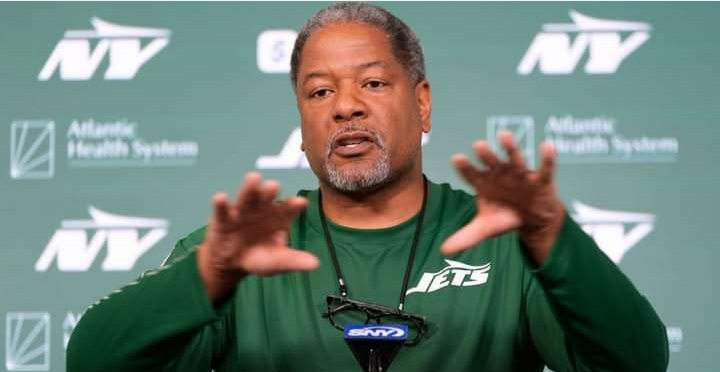FLORHAM PARK, N.J. — A look at what’s happening around the New York Jets:
1. Recharged and ready: Steve Wilks went from the San Francisco 49ers to the Charlotte 49ers, from the bright lights of the Super Bowl stage to the solitude of a darkened film room on a college campus. Quite a journey for the Jets’ new defensive coordinator.
He helped out at practice in the morning, then watched a lot of tape in the afternoon. On Mondays, he devoured NFL tape, studying the previous day’s games — certain teams, schemes, situations, etc. Because of a friendship with now Jets coach Aaron Glenn, he kept a close eye on the Detroit Lions and how the defense performed under Glenn last season.
The experience “really helped me tremendously,” Wilks, 55, said this week in his first media availability since being hired by Glenn. “It was great to reset and recharge, but [I] learned a lot throughout that process and I was ready to get back into the saddle.”
Giddy up.
Wilks inherits a unit with eight returning starters, including one former Pro Bowl or All-Pro player on each level of the defense — defensive tackle Quinnen Williams, linebacker Quincy Williams and cornerback Sauce Gardner. Wilks said Gardner and Quinnen Williams are among the best in the league at their positions, adding that Quincy Williams and Jamien Sherwood are “two great linebackers.”
The Jets finished No. 3 in yards allowed for the second straight year, but anybody who watched them play knows that lofty ranking was totally deceiving. They were No. 23 in defensive EPA, a better reflection of their performance. Like the entire team, the defense underachieved.
“They had all the talent in the world, but they never played that way,” said a longtime NFL coach, who studied the Jets on tape.
Wilks and Glenn are like-minded in that they both like to blitz a lot. It’ll be interesting to see how they play on the back end. Glenn prefers man coverage; statistically, Wilks leans toward zone. He said the defense will be a “collaboration” of their schemes. Early indication: They will be more aggressive and more physical than last season.
“It’s not really about our playbook, it’s about our play style,” said Wilks, repeating one of Glenn’s favorite lines.
Wilks’ biggest challenges are integrating cornerback Brandon Stephens and safety Andre Cisco into the lineup, sorting out the crowded defensive tackle situation, developing depth at all three levels and recapturing the defensive swagger that vanished last season. Wilks, the Arizona Cardinals‘ head coach in 2018, also can be a sounding board for Glenn, a first-timer in the big chair.
“Sometimes in that seat, it gets lonely, and you don’t have that sounding piece, that individual to communicate and speak with,” Wilks said. “So I’m here for that.”
Swap city: Quarterback history could be made in Week 1.
If Aaron Rodgers signs with the Pittsburgh Steelers, as many expect, the Rodgers-Justin Fields matchup will be the first season-opening game between starting quarterbacks who swapped teams they started for the previous year, per ESPN Research.
3. Lights, camera, hut: When he was behind center for the Jets, Rodgers always attracted a lot of cameras. You still see cameras at practice, except now some of them are on the heads of the quarterbacks.
Each of the four quarterbacks are wearing a small camera on their helmet, capturing video and audio that can be studied later.
Quarterbacks coach Charles London called it “a great learning tool,” noting that the microphone allows them to hear the playcall in the huddle and the communication at the line of scrimmage. He said the video helps the quarterback retrace his progressions on each pass play.
“Instead of trying to guess — ‘Where did your eyes start [on a particular play]?’ — we’ll go back and watch it,” London said. “You can see where his eyes started and you can see how he went in his progression.”
They experimented with the cameras in rookie minicamp and decided to keep them for the remainder of the offseason. It’s not a totally radical concept; years ago, the Jets used virtual reality technology to assist in practice and game evaluation.
4. Time to get physical: There’s a mantra in the wide receiver room: “No block, no rock.”
The new staff has placed an emphasis on perimeter blocking by the wide receivers, essential for explosive plays in the running game. The Jets were lacking in that department last season, as they produced only 45 rushes of 10 yards or more, which ranked 24th
They can’t truly sharpen their blocking skills in the offseason because the practices are padless, but they certainly have enough size at receiver to form a good blocking group. Their biggest bodies belong to Allen Lazard (6-foot-5, 227 pounds) and Josh Reynolds (6-3, 192).
They have the same position coach as last season (Shawn Jefferson), but Garrett Wilson acknowledged that the receivers’ responsibilities are “a little different” than in the past. For example, he said there might be plays where he’s required to seek out and block a safety.
“These are things that maybe I haven’t been asked to do,” Wilson said, “but it says a lot about the culture.”
5. Getting real: OTA practices aren’t as intense as training camp, but that doesn’t mean Glenn will accept a lax effort. Wednesday was one of those days. He “didn’t like the energy of the practice,” according to Fields.
“After practice, he told us straight up how he felt,” Fields said.
That’s the early word on Glenn: He’s blunt and direct, no sugarcoating. Fields called him “one of the realest coaches” he’s played for.
6. Eye on the run: Quinnen Williams said he’s trying to improve his play as a run defender — specifically, his ability to shed blocks. He acknowledged he made “a lot of mistakes” last season. In fact, he ranked 30th in ESPN’s run stop win rate among interior linemen, down from 12th in 2023.
One opposing scout said the Jets’ run defense should be better than last season because the scheme will be more committed to run-stopping than the previous one, which was predicated on pass rushing.

